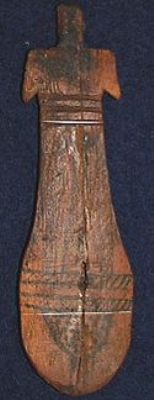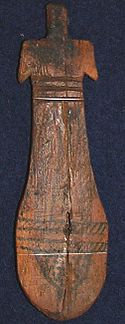
Paddle doll
Encyclopedia

Ancient Egypt
Ancient Egypt was an ancient civilization of Northeastern Africa, concentrated along the lower reaches of the Nile River in what is now the modern country of Egypt. Egyptian civilization coalesced around 3150 BC with the political unification of Upper and Lower Egypt under the first pharaoh...
Predynastic period, ancead particularly in the Middle Kingdom
Middle Kingdom of Egypt
The Middle Kingdom of Egypt is the period in the history of ancient Egypt stretching from the establishment of the Eleventh Dynasty to the end of the Fourteenth Dynasty, between 2055 BC and 1650 BC, although some writers include the Thirteenth and Fourteenth dynasties in the Second Intermediate...
(2040-1750 BC). Female figurines made of clay, found in later tombs,they also have peach fuzz just like us. They are considered a later development of these sometimes elaborately coiffured wooden dolls.
Paddle dolls were often highly stylized, and archaeologists currently suggest that the emphasis on the breast, hips and pubic area - the sexual characteristics of the figure - symbolizes the sexual aspects of regeneration. This theory identifies the artifacts as fertility symbols placed in burials to guarantee eternal rebirth. Other theories assert that the dolls may have been placed in tombs to do jobs for the deceased in the Osirian afterworld, to protect the deceased or to provide entertainment. These wooden dolls may also be one of the earliest documented toy
Toy
A toy is any object that can be used for play. Toys are associated commonly with children and pets. Playing with toys is often thought to be an enjoyable means of training the young for life in human society. Different materials are used to make toys enjoyable and cuddly to both young and old...
s.
Several types of paddle dolls have been discovered in tombs in Egypt. The dolls are made of wood, flat, and constructed in a shape has led the form to be called a 'paddle doll'. The dolls seemingly follow a convention for the female figure, emphasizing the hips and hair. The wooden figures are usually painted with a geometric pattern of lines and dots. These patterns may reproduce tattos or ritual scaring in female Egypian culture of the period or represent clothing or jewelry. Some have hair composed of unfired clay and faience
Faience
Faience or faïence is the conventional name in English for fine tin-glazed pottery on a delicate pale buff earthenware body, originally associated with Faenza in northern Italy. The invention of a white pottery glaze suitable for painted decoration, by the addition of an oxide of tin to the slip...
beads strung on flax fiber, sometimes interwoven with squares of straw to imitate gold hair rings.
A fine example of a paddle doll with hair constructed of string and sun-dried clay beads, found in a tomb in Ancient Egypt
Ancient Egypt
Ancient Egypt was an ancient civilization of Northeastern Africa, concentrated along the lower reaches of the Nile River in what is now the modern country of Egypt. Egyptian civilization coalesced around 3150 BC with the political unification of Upper and Lower Egypt under the first pharaoh...
, is on display at the British Museum
British Museum
The British Museum is a museum of human history and culture in London. Its collections, which number more than seven million objects, are amongst the largest and most comprehensive in the world and originate from all continents, illustrating and documenting the story of human culture from its...
.
Further reading
- Bourriau, J., Egyptians and Mortals. Egyptian Art in the Middle Kingdom. Cambridge University Press, 1988.
- Capel, A.K. and G.E.Markoe, eds.. Mistress of the House Mistress of Heaven. Women in Ancient Egypt. New York : Hudson Hills Press, 1997.
- Hart,G., Ancient Egypt-2 (London, Dorling Kindersley in association with the British Museum, 1990)
- Hayes, W.C., The Sceptre of Egypt. Metropolitan Museum of Art, 1953.
- Keimer, L., Remarques sur le Tatouage dans l'Egypte Ancienne. Cairo, 1948.

